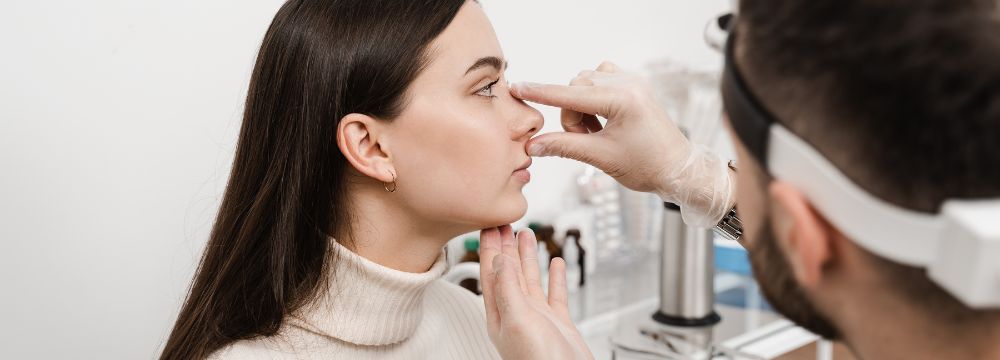
A Guide to Rhinoplasty
Rhinoplasty, commonly known as a ‘Nose Job’, is a Plastic Surgery procedure that reshapes and redefines the nose. Client motivations for nose surgery varies – from clients wanting to alter the appearance of their nose to those seeking to address more functional concerns. Read on as we answer some of our most asked questions, including how much a Rhinoplasty costs in Australia, Nose Surgery Recovery and whether Medicare covers Rhinoplasty. We also share real client Before & After Results.
INDEX
What Is Rhinoplasty?
Offered in Sydney, Rhinoplasty is an intricate procedure that involve changes being made to the nose surgically – this could mean adjusting the shape, size or the cartilage inside. These surgeries may seek to address a client’s aesthetic concerns including:
Rhinoplasty is a complex Facial Plastic Surgery procedure that should only be performed by a highly qualified, experienced and trusted Plastic Surgeon. As with any Plastic Surgery procedure, we recommend all clients conduct their own research, particularly around Risk and Recovery and seek the opinion of healthcare professionals before deciding if this procedure is the right decision for you.
How much does a nose job cost in Australia?
Rhinoplasty Price Sydney
CosMediTour’s comprehensive Rhinoplasty packages include:
- Plastic Surgeon Fees
- General Anaesthetist Fees
- Premier Private Hospital Fees
- Personal Client Manager to Support You Throughout Your Journey
SYDNEY RHINOPLASTY PRICED FROM $14,990 *
RHINOPLASTY is an intricate Plastic Surgery procedure that reshapes or redefines the nose. Rhinoplasty is commonly referred to as a Nose Job.
SYDNEY RHINOPLASTY PRICES
Sydney Rhinoplasty from $14,990 * VIEW PACKAGE +
*The prices on this page reflect a standard case. Clients with a greater degree of surgical complexity will incur higher fees. The easiest way to receive your personalised Quote, is to complete a free Online Assessment.
Does Medicare Cover Rhinoplasty in Australia?
Can you get a nose job on Medicare?
Your eligibility for a Medicare rebate would be determined by your General Practitioner and your performing Surgeon. For further assistance, please call us on 1300 000 633 or submit an Enquiry and one of our friendly Client Support Specialists will be in touch.
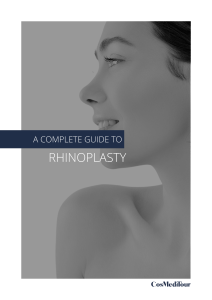
Download Our Rhinoplasty Guide.
"*" indicates required fields
What Can A Rhinoplasty Address?
Should I Get a Nose Job?
Client motivations vary and can be aesthetically or medically driven. Typically however, our clients are seeking to address one or more of the following through their procedure.
1. Nasal Straightening
Clients might seek to straighten their nose to:
- Alter the appearance of the nose and correct asymmetries
- Alter their nose shape after an injury or trauma
- Remove humps or bumps
In some cases, the straightening can be internal – for example, Septoplasty, where crooked cartilage inside the nose is removed to clear the airways – see Deviated Septum Correction.
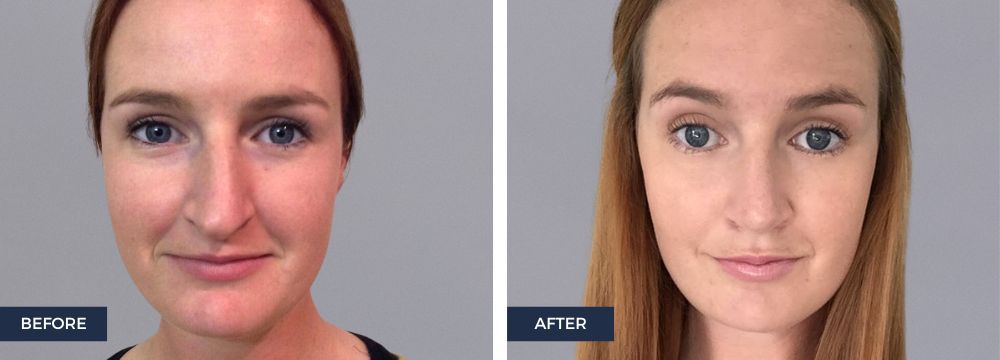
Results shown: 3 months post-surgery
2. Nasal Tip Refinement
Nasal Tip Refinement, also known as ‘Tip Rhinoplasty’ or ‘Nasal Tip Surgery’, involves a Plastic Surgeon reducing or reshaping the nasal tip. While it can be offered as a standalone, Often a Tip Refinement is incorporated as a way to compliment changes to the overall nose shape and size.
Nasal tips vary from client to client. Clients seeking this refinement often present with one or more of the following concerns:
- Large or bulbous tip
- Flat tip
- Droopy tip
- Prominent tip
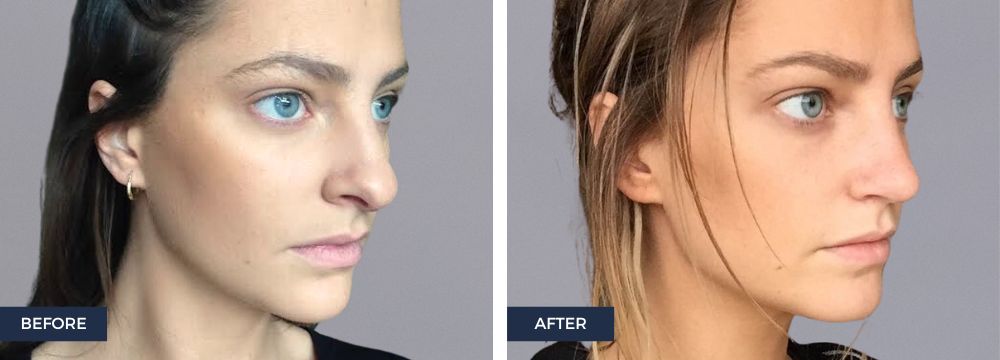
Results shown: 2 months post-surgery
3. Nose Hump Removal
Humped, or ‘hooked’ noses may not be detected from a frontal view: however, humps on the nasal bridge are noticeable when viewing a client’s side profile. Plastic Surgeons can shave the bone and/or cartilage to flatten the nasal bridge, or perform a Preservation Rhinoplasty.
Preservation Rhinoplasties involve the removal of small portions of bone and cartilage from under the nasal bridge. It is a strategic, top-down approach that works to remove humps without altering the dorsal lines – the shape and spread of the nose.
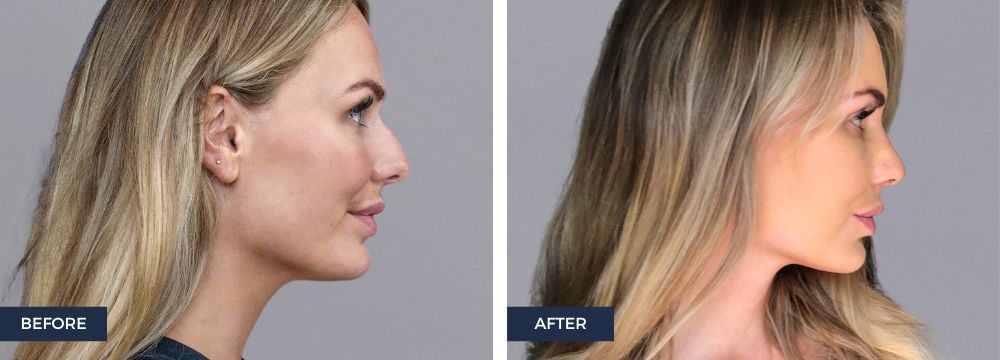
Results shown: 6 weeks post-surgery
4. Septal Deviation Correction
A deviated septum refers to a condition where the cartilage inside the nose is misaligned. A Deviated Septum may occur following injury, or in some cases may be a congenital condition.
In severe cases, a Deviated Septum may cause breathing problems through one or both sides of your nose. In these instances, clients may undergo a ‘Septoplasty’ to clear their airways. A Septoplasty can be performed in conjunction with Rhinoplasty to straighten both the inside and outside of their nose.
Depending on the degree of deviation, a perfectly straight nose cannot always be guaranteed.
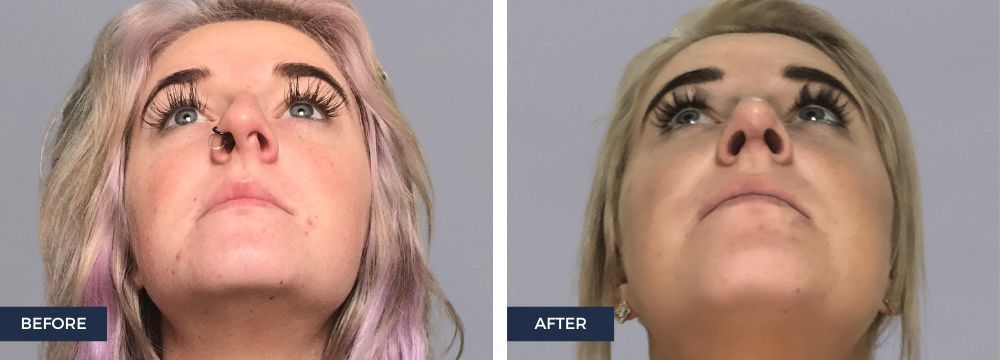
Results shown: 6 weeks post-surgery
5. Hanging Columella Correction
Your columella is the bridge of tissue that separates the nostrils at the bottom of your nose. A Hanging Columella refers to when the tissue is longer than the edge of the nostril, so more nostril is visible from the side.
Hanging or Drooping Columellas can be surgically corrected by shortening their length.
A Hanging Columella is common with clients who have a nasal tip that projects significantly. So, our Plastic Surgeons often combine techniques to correct Hanging Columella while also reducing nasal projection for a petite, less protruding nose.

Results shown: 1 week post-surgery
6. Rhinoplasty to Reduce the Size and Projection of the Nose
This procedure can alter the size and projection of the nose. Surgeons can:
- Remove portions of bone or cartilage from the nose
- Refine the height of the nose via Preservation Rhinoplasty
- Conducted an Alarplasty
An Alarplasty, or Alar Base Reduction is a technique used to decrease the size of the nostrils. When performed in conjunction with other refinements, Alarplastys can contribute to an overall resizing of the nose.
Larger noses may also be a result of skin thickness. In these instances, it may be difficult for Surgeons to predict how much a nose can be reduced in size and while refinements can still be made, individual results will vary. Recovery times may also be longer in these instances.
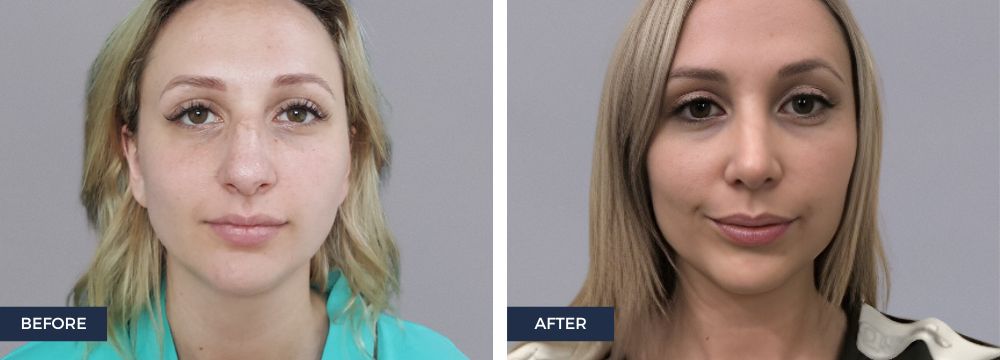
Results shown: 1 month post-surgery
Rhinoplasty Techniques
What’s Involved in a Nose Job?
No nose is the same and there are a number of approaches your Plastic Surgeon can take with your Rhinoplasty. Your unique Treatment Plan will vary according to your desired result and the existing structure of the nose.
Open Rhinoplasty
An Open Rhinoplasty (or External Rhinoplasty) allows surgeons to gain direct access to the internal structure of the nose. During an Open Rhinoplasty, three incisions are made. The first two are made in each of the nostrils and the third, across the columella (the strip of tissue that separates the nostrils at the base of the nose). From there, the surgeon will lift the top portion of the nose to work on the structures beneath.
Open Rhinoplasty with Cartilage Grafting
This approach is used to provide additional support, reshape the nasal tip, correct asymmetry and reinforce weakened areas of the nose. During this procedure, cartilage is harvested from the rib, ear or Cadarvic Cartilage sources. The harvested cartilage is then placed to achieve the desired changes in the nasal structure.
Excisional Rhinoplasty
An Excisional Rhinoplasty involves the incremental removal of bone and cartilage (often quite a substantial amount). The technique relies on the formation of scar tissue to pull the nose into shape and is often completed using the Closed approach. One of the biggest risks associated with this technique is the weakening of the overall nose structure where over time, the scar tissue is not enough to support the nose structure and it can appear deformed.
Structural Rhinoplasty
Structural Rhinoplasties focus on reinforcing the nose structure. While large amounts of bone and cartilage are removed, they aren’t discarded. Surgeon’s use the client’s excess tissue to reshape the nose. Bone and cartilage is repositioned where it can be better used to create the required contour. A Structural Rhinoplasty is most often performed using an Open approach; however, in some circumstances a Closed approach may also be used.
Preservation Rhinoplasty
Preservation Rhinoplasty aims to retain as much of the client’s original bone and cartilage as possible. Rather than using the ‘top-down’ approach of a Structural Rhinoplasty, surgeons go under the nasal dorsum (bridge) to remove small portions of bone and cartilage. The technique is commonly used to reduce the height of the bridge and remove any humps/bumps without altering the dorsal lines (the shape/spread of the nose).
Preservation Rhinoplasty is best suited to first-time clients and those not requiring a complex reconstruction.
Rhinoplasty Before and After Images
Client Results
Discover the results achieved by our highly-qualified, experienced Plastic Surgeons in our Before and After Gallery. All images featured in the Gallery are actual CosMediTour clients who have given consent to have their photos published.
Please note that results vary between individuals, and the images shared in the gallery do not guarantee that your outcome will be the same. Images may contain nudity and are not intended for people under the age of 18.
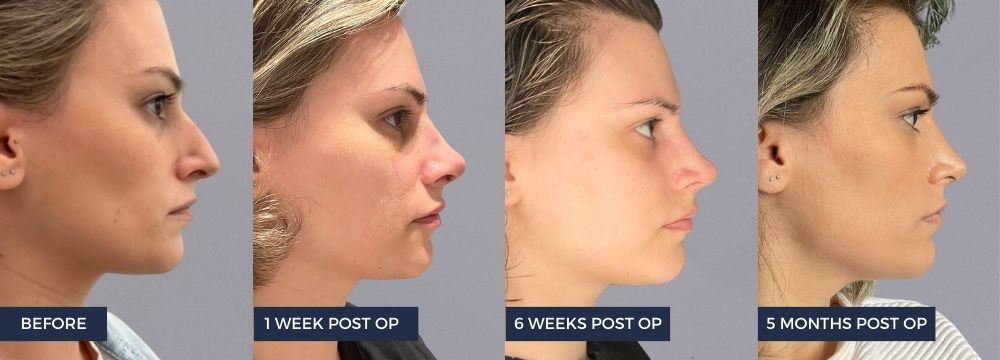
Rhinoplasty Risk and Recovery
Are Nose Jobs Painful?
Pain experienced after a Nose Job varies from person to person. In the days following your nasal surgery, clients can experience swelling, bruising, soreness around the nose and facial area, and potentially some minor bleeding. Your Plastic Surgeon will prescribe pain medication to manage any discomfort effectively. It’s important to communicate your pain tolerance and concerns to ensure a comfortable and smooth recovery process. READ MORE +
Are Nose Jobs Dangerous?
While you can rest assured that you’ll be in the most capable surgical hands throughout your CosMediTour Plastic Surgery, there are potential risks to consider with all forms of surgery. READ MORE +
FURTHER Information
To learn more about Rhinoplasty, feel free to connect with our friendly Client Support Team.
